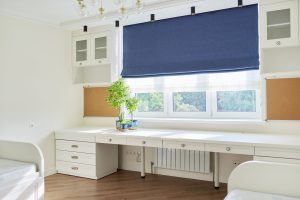When you’re deciding between blinds, shades, and shutters for your windows, it’s important to weigh their distinct advantages. Blinds offer precise control over light and privacy, perfect for large windows or sliding doors. Shades, in contrast, bring a softer touch, with various light-filtering options and added insulation benefits. Shutters combine elegance and functionality, lending a timeless appeal to any room. But how do you determine which is the best fit for your space? Understanding the nuances of each option can guide you towards a cohesive and stylish solution. Let’s break down these choices further.
Key Takeaways
– Blinds offer precise control over light and privacy with various material options.
– Shades provide excellent insulation and can range from sheer to blackout for light filtering.
– Shutters add durability and timeless elegance, available in wood, faux wood, and composite.
– Motorized versions are available for blinds and shades, enhancing convenience and functionality.
– Choose blinds for granular light control, shades for insulation, and shutters for a classic look.
Understanding Blinds
When choosing window treatments, blinds offer a versatile and sleek solution that combines functionality with modern design. Blinds come in various materials such as wood, aluminum, and faux wood, allowing you to match them with any interior style. Their slatted design provides precise control over light and privacy, which is essential for optimizing room ambiance.
In terms of design principles, blinds can either be a focal point or seamlessly blend into your existing decor. Horizontal blinds are ideal for large windows, while vertical blinds work well for sliding doors and tall windows. The clean lines and minimalistic look of blinds can enhance a contemporary setting or provide a subtle contrast in a more traditional space.
The aesthetic focus is also paramount; considering finishes and colors can make a significant difference. For instance, white or neutral-colored blinds can make a room appear larger and more open, whereas darker shades can add depth and a touch of sophistication.
Integrating motorized options can elevate the functionality, making it easier to adjust the blinds with a remote or smartphone app.
Exploring Shades
Often considered for their softness and versatility, shades offer an elegant and practical solution for window treatments that cater to a variety of aesthetic and functional needs. Unlike blinds, shades are constructed from continuous pieces of fabric, giving you a sleek and seamless look. This design choice allows for a wide range of textures, colors, and patterns, perfect for complementing any interior décor scheme.
When selecting shades, you’ll encounter several types, such as roller shades, Roman shades, and cellular shades. Roller shades provide a minimalist aesthetic and are ideal for modern interiors. Roman shades introduce a touch of classic elegance with their soft, cascading folds. Cellular shades, on the other hand, are designed with honeycomb structures that offer superior insulation, enhancing your home’s energy efficiency.
Expert designers appreciate the light-filtering capabilities of shades, which range from sheer to blackout options. This flexibility allows you to control natural light and privacy according to your specific needs. You’ll also find motorized versions that integrate seamlessly with smart home systems, adding a layer of convenience and sophistication.
Getting to Know Shutters
Incorporating a timeless blend of elegance and functionality, shutters are a sophisticated choice for window treatments that can enhance both traditional and modern interiors. Their sturdy construction and classic appeal make them a versatile option for any design scheme. Shutters not only enhance aesthetic appeal but also offer practical benefits regarding light control, privacy, and insulation.
When considering shutters, keep in mind these aspects:
- Materials: Choose between wood, faux wood, and composite materials. Wooden shutters offer a natural, warm feel, while faux wood and composite provide durability and moisture resistance.
- Louver Size: Louvers come in various sizes, typically ranging from 2.5 to 4.5 inches. Smaller louvers offer a more traditional look, while larger ones provide a contemporary, streamlined appearance.
- Mounting Options: Decide between inside or outside mounts. Inside mounts fit within the window frame for a seamless look, whereas outside mounts can cover imperfections and create a bold statement.
- Customization: Opt for custom-made shutters to guarantee a perfect fit and finish. Tailored shutters can complement your window’s unique dimensions and style.
Comparing Functionality
Understanding the distinct functionalities of blinds, shades, and shutters will empower you to make an informed decision that enhances both the aesthetic and practical aspects of your space.
Blinds, typically made of horizontal or vertical slats, provide granular control over light filtration and privacy. You can easily adjust the slats to allow varying degrees of sunlight while maintaining privacy, making them ideal for spaces where light control is paramount.
Shades, on the other hand, are fabric-based and offer a smoother, more uniform appearance. They can be rolled up or down, allowing for complete or partial coverage. Their insulating properties make shades particularly effective in regulating indoor temperatures, adding an energy-efficient element to your design.
Shutters, often crafted from wood or faux wood, combine durability with timeless elegance. They’re affixed to the window frame and can be swung open or closed, offering excellent ventilation and light control. Their robust construction also adds a layer of security and sound insulation.
Each option serves distinct functional purposes, so aligning these with your design goals and daily needs will help you select the perfect window treatment. The key lies in balancing form and function to create a cohesive, functional, and visually appealing space.
Choosing the Right Option
Selecting the right window treatment requires a keen eye for design principles and an understanding of how each option aligns with your aesthetic and functional needs. Blinds, shades, and shutters each offer unique benefits that can dramatically impact your space.
To make an informed choice, consider the following factors:
- Light Control: If you need precise control over light levels, blinds are your best bet. Their adjustable slats allow you to fine-tune the amount of light entering your room, creating the perfect ambiance.
- Insulation: For superior energy efficiency, shades, especially cellular shades, excel in providing insulation. Their design traps air, keeping your room warmer in winter and cooler in summer.
- Aesthetic Appeal: Shutters bring an element of timeless elegance. Crafted from wood or composite materials, they can be custom-painted to match your décor, adding a sophisticated touch to any room.
- Privacy: If privacy is paramount, roller shades or shutters provide excellent coverage. Roller shades can be fully lowered to block outside views, while shutters offer a sturdy, opaque barrier.
Frequently Asked Questions
How Do I Maintain and Clean Each Type of Window Treatment?
Dust blinds regularly with a microfiber cloth, use a vacuum on low setting for shades, and wipe shutters with a damp cloth. Always avoid harsh chemicals to maintain the aesthetic integrity and longevity of your window treatments.
What Are the Cost Differences Between Blinds, Shades, and Shutters?
Managing cost differences is like painting with a full palette. Blinds are generally the most affordable, shades offer mid-range pricing with varied styles, and shutters, with their timeless appeal, tend to be the most expensive.
Are There Eco-Friendly Options Available for Blinds, Shades, and Shutters?
Yes, you’ll find eco-friendly options. Look for blinds made of recycled aluminum or sustainably sourced wood, shades crafted from organic fabrics, and shutters using low-VOC paints. These choices align with sustainable design principles and aesthetic elegance.
How Do These Window Treatments Affect Energy Efficiency in My Home?
These window treatments enhance energy efficiency by providing insulation. Blinds allow adjustable light control, shades offer thermal barriers, and shutters create airtight seals. Each option boosts your home’s aesthetic while reducing energy consumption.
Can I Install Blinds, Shades, or Shutters Myself, or Should I Hire a Professional?
Installing window treatments yourself can be a double-edged sword. With precision and patience, you can achieve a stunning result. However, hiring a professional guarantees flawless execution, adhering to design principles and aesthetic focus.
Conclusion
So, you’ve navigated the labyrinth of blinds, shades, and shutters. You’ve weighed the light-filtering nuances of shades, the precise control of blinds, and the timeless elegance of shutters.
The real question is, will you ever make up your mind? Or will you just throw a bed sheet over your windows and call it avant-garde?
Remember, window treatments aren’t just functional—they’re the exclamation point on your interior design statement. Choose wisely, or at least, stylishly.
















